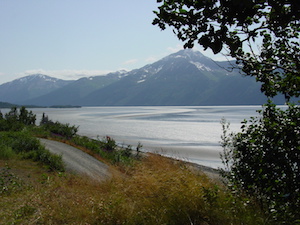 Introduction
Introduction
This tutorial should take you about one to one and one-half hours to complete. You can stop at any time and pick up where you left off. There is no quiz at the end! Please be sure you have completed the preparations below before you begin.
The goal is to provide an overview of the Earth system, which also serves as our climate system. To understand climate change, we need to begin with the Earth and its components – land (or rock), life, water, and air- our lithosphere, biosphere, hydrosphere, and atmosphere.
We’ll begin with developing a very basic understanding of systems science and then apply that to Earth’s systems, tying these concepts to your own site as we progress.
With this foundation we will briefly describe some major drivers of Earth’s climate patterns, in particular the coupling of the ocean and atmosphere, and challenge you to consider how these patterns may influence the climate of your region.
Learning Objectives
- Describe how scientists approach the discipline of Earth System Science (i.e. the notion of a holistic view of the planet and the use of multiple modes of inquiry including modeling).
- Explain how the five spheres of the Earth system (geosphere, hydrosphere, biosphere, atmosphere, cryosphere) are interconnected, in terms of energy flow and matter cycling at the global and local scale.
- Describe how your location is connected to the five spheres and provide one example for each sphere.
- Describe the carbon cycle in general terms and identify a local example.
- Explain how Earth’s interrelated systems (the five spheres, energy flow, and matter cycling) interact to produce regional climate patterns around the globe.
Before you start
 Before beginning this tutorial, find a photograph that shows part of your park or interpretative site that you can use in this activity. This should be a landscape shot that you might consider to be representative of what makes your interpretative site special. Note: if you do not work at a site per se, please use a photo of the area in which you live or work. It will be best if you can enlarge this image to about 8.5 X 11. You will also need a piece of tracing paper or a sheet of plastic that can be used as an overlay upon which you will be writing responses to exercises in the module. Alternatively you can sketch the main things in your photo, and use that sketch in your responses.
Before beginning this tutorial, find a photograph that shows part of your park or interpretative site that you can use in this activity. This should be a landscape shot that you might consider to be representative of what makes your interpretative site special. Note: if you do not work at a site per se, please use a photo of the area in which you live or work. It will be best if you can enlarge this image to about 8.5 X 11. You will also need a piece of tracing paper or a sheet of plastic that can be used as an overlay upon which you will be writing responses to exercises in the module. Alternatively you can sketch the main things in your photo, and use that sketch in your responses.
Set this photograph aside for use later in the tutorial.
You may want to download now the reading, Multiple Modes of Inquiry in Earth Science Note: This is an external link, please be sure to return to this page once you've done the download. Set this article aside for use later in the tutorial.
